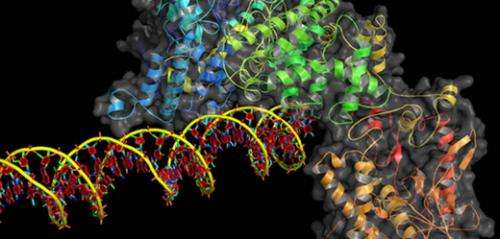April 23, 2015 report
Chinese team performs gene editing on human embryo

(Phys.org)—A team of researchers in China has announced that they have performed gene editing on human embryos. In their paper uploaded to the open access site Protein & Cell (after being rejected by Nature and Science) the researchers defended their research by pointing out that the embryos used in their research were non-viable.
It has been only recently that scientists have had a tool that allows for directly editing a genome—called CRISPR, it allows for removing a single (defective) gene from a genome and replacing it with another one, to prevent genetic diseases. CRISPR has been used to edit animal embryos and adult stem cells, but up till now, no one has used the technique to edit the genome of human embryos due to ethical issues—or if they have, they have not acknowledged it publicly—this effort by the team in China has crossed that ethical line and because of that the announcement will likely incite condemnation by some and stir a new round of debate regarding the ethics of conducting such research.
The researchers report that their desire was to see how well CRISPR would work on human embryos. To find out, they collected 86 doubly fertilized embryos from a fertilization clinic—such embryos have been fertilized by two sperm and cannot mature beyond just a tiny clump of cells, they die naturally before growing into anything. The team reports that 71 of the embryos survived to grow enough for use in the CRISPR experiment. Unfortunately, the researchers found that the technique worked properly on just a fraction of the total, and only small percentage of those managed to relay the new gene properly when they split. They also found that sometimes the procedure wound up splicing the wrong gene segment, which led to inserting new genes in the wrong places—which in normal embryos could lead to a new disease. Additionally, of those that did get spliced and put in the right place, many were mosaic, a term used to describe a mix of old and new genes, which in addition to also leading to a new disease, could lead doctors to misidentify gene splicing results in normal embryos.
The researchers conclude by suggesting that the problems they encountered should be investigated further before any type of clinical application is begun.
More information: CRISPR/Cas9-mediated gene editing in human tripronuclear zygotes, Protein & Cell, April 2015. DOI: 10.1007/s13238-015-0153-5 . link.springer.com/article/10.1007%2Fs13238-015-0153-5
ABSTRACT
Genome editing tools such as the clustered regularly interspaced short palindromic repeat (CRISPR)-associated system (Cas) have been widely used to modify genes in model systems including animal zygotes and human cells, and hold tremendous promise for both basic research and clinical applications. To date, a serious knowledge gap remains in our understanding of DNA repair mechanisms in human early embryos, and in the efficiency and potential off-target effects of using technologies such as CRISPR/Cas9 in human pre-implantation embryos. In this report, we used tripronuclear (3PN) zygotes to further investigate CRISPR/Cas9-mediated gene editing in human cells. We found that CRISPR/Cas9 could effectively cleave the endogenous β-globin gene (HBB). However, the efficiency of homologous recombination directed repair (HDR) of HBB was low and the edited embryos were mosaic. Off-target cleavage was also apparent in these 3PN zygotes as revealed by the T7E1 assay and whole-exome sequencing. Furthermore, the endogenous delta-globin gene (HBD), which is homologous to HBB, competed with exogenous donor oligos to act as the repair template, leading to untoward mutations. Our data also indicated that repair of the HBB locus in these embryos occurred preferentially through the non-crossover HDR pathway. Taken together, our work highlights the pressing need to further improve the fidelity and specificity of the CRISPR/Cas9 platform, a prerequisite for any clinical applications of CRSIPR/Cas9-mediated editing.
See also: The ISSCR has responded to the publication of gene editing research in human embryos
via Nature
© 2015 Phys.org



















